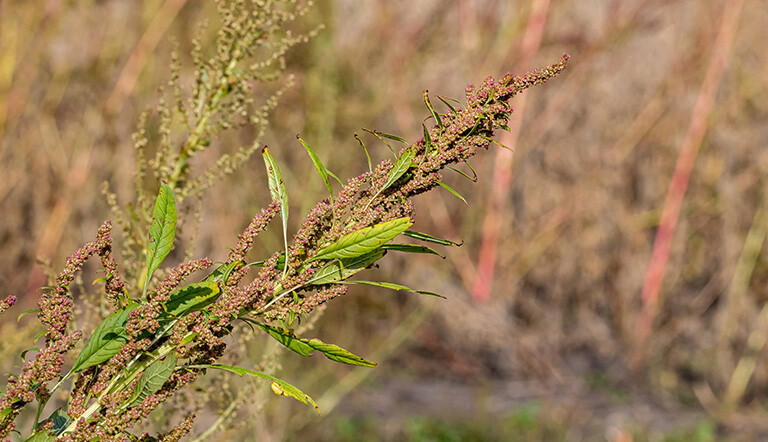
Pest Profile: Waterhemp

KEY CHARACTERISTICS
Type: Annual
Germination: Spring, typically after lamb’s-quarters.
Seed Production: Each plant yields 15,000 to 25,000 seeds.
Seed Dispersal: Human activities, such as the movement of machinery, water, birds and other animals, and to some degree wind. Seeds may also move via contaminated manure and compost. Waterfowl have been documented to disperse seeds with an estimated 1800 mile range.
Root System: Taproot - can extend over 25 inches deep into the soil, and secondary roots may reach over six ft beyond the plant stem.
PLANT GROWTH
Competitive Environments: Erect stem. The growth rate of Waterhemp ranges from 2.5 to almost 4 centimeters per day.
Open Environment: Erect Stem.
Leaf Structure: Cotyledons: Linear, narrow, purple-red underneath. Mature leaves: Lance-shaped (tapered and typically with a pointed tip), with a wavy margin.
ENVIRONMENTAL ADAPTIBILITY
Waterhemp has adapted to tolerate a range of environmental conditions, with a preference for well drained, nutrient rich soils. Similar to those preferred by cultivated crops. Plants can tolerate a soil pH from 4.5 – 8 and temporary flooding but does not do well in high saline areas.
WATERHEMP RESISTANCE OVERVEIW
Genetic Variability:
Resistant genes can spread with the movement of pollen, allowing it to spread rapidly during reproductive periods. Sites of action controlled by chemicals should be rotated.
REPRODUCTIVE BIOLOGY
Waterhemp reproduces by seed, dioecious, has separate male and female plants. Female Waterhemp plants can produce up to 1,000,000 seeds, but 35,000-200,000 seeds are typical. Seeds can remain viable in the soil for several years, with ~12% persistence after 4 years.
CONFIRMED HERBICIDE RESISTANCE
- Group 2 (ALS Inhibitors)
- Group 3 (Microtubule Assembly Inhibitors)
- Group 4 (Synthetic Auxins)
Group 5 (PSII Inhibitors) - Group 9 (Glyphosate/EPSPS Inhibitors)
Group 14 (PPO Inhibitors) - Group 15 (VLCFA Inhibitors
- Group 27 (HPPD Inhibitors)
INTEGRATED PEST MANAGEMENT
- Crop rotations are key. This creates a diverse environment which can help suppress weed populations. Aim for a 3- or 4-year rotation.
- Scouting and proper identification is key for Waterhemp since it resembles other pigweed species but is much more aggressive. A zero-tolerance approach is encouraged due to the herbicide resistance it has established.
- Implementing narrow row spacing (either drilled or 38 cm row spacing) along with high plant densities—ranging from 140,000 to 160,000 seeds per acre for soybeans, can enhance crop competitiveness.
- Deep tillage, which places seeds at depths that inhibit emergence, can help manage weed populations. When used alongside residual herbicides, deep tillage has been shown to reduce the emergence of pigweeds, including Waterhemp, by up to 97%. However, deep tillage also has potential downsides that need consideration.
- Planting fall cover crops, especially cereal rye, can reduce the emergence of Waterhemp the following spring by providing early-season competition. In crop rotations, both spring and winter wheat are beneficial for managing Waterhemp populations.
- The use of full-rate residual herbicides, applied before or after planting (as per label guidelines based on soil type and organic matter content), can help suppress Waterhemp. Relying solely on post-emergence herbicides can lead to herbicide resistance in Waterhemp. A soil-applied, residual herbicide like a Group 15 product can effectively control early emerging Waterhemp and delay its growth, allowing the crop to better compete.
- Avoid reducing herbicide application rates, as full rates provide longer-lasting control, helping to delay waterhemp emergence for as long as possible. Depending on the herbicide resistance profile, suitable soil-residual herbicides include those from Groups 5, 15, and 27 for corn, and Groups 5, 14, and 15 for soybeans.
References:
Ontario Ministry of Agriculture, Food and Rural Affairs. (n.d.). Waterhemp. Ontario.ca. Retrieved November 19, 2024, from https://www.ontario.ca/document/weed-identification-guide-ontario-crops/waterhemp
Integrated Weed Management. (2022, October). Waterhemp: Identification, biology, and management. Retrieved November 19, 2024, from https://growiwm.org/wp-content/uploads/2022/10/Waterhemp.pdf
Missouri Extension. (2019). Waterhemp in Missouri field crops (MX1137). University of Missouri Extension. Retrieved November 19, 2024, from https://extension.missouri.edu/media/wysiwyg/Extensiondata/Pub/pdf/miscpubs/mx1137.pdf
Cornell University. (n.d.). Waterhemp (Amaranthus tuberculatus). Cornell University College of Agriculture and Life Sciences. Retrieved November 19, 2024, from https://cals.cornell.edu/weed-science/weed-profiles/waterhemp#:~:text=Costea%20et%20al.-,2005).,is%20low%20(USDA%20Plants)
Purdue University. (2020, July 7). Waterhemp biology and control in corn. Field Crops News. Retrieved November 19, 2024, from https://fieldcropnews.com/2020/07/waterhemp-biology-and-control/#corn
The Western Producer. (2020, August 13). Canola, cereal crops slow Waterhemp’s spread west. Retrieved November 19, 2024, from https://www.producer.com/news/canola-cereal-crops-slow-waterhemps-spread-west/
Integrated Weed Management. (n.d.). Waterhemp. Retrieved November 19, 2024, from https://growiwm.org/weeds/waterhemp/
Illinois Extension. (2021, June 11). Integrated pest management key to preventing herbicide-resistant weeds like waterhemp. University of Illinois Extension. Retrieved November 19, 2024, from https://extension.illinois.edu/blogs/acres-knowledge/2021-06-11-integrated-pest-management-key-preventing-herbicide-resistant
Bradley, K., & Bish, M. (2020). Waterhemp management in soybeans. Retrieved from https://weedscience.missouri.edu/.